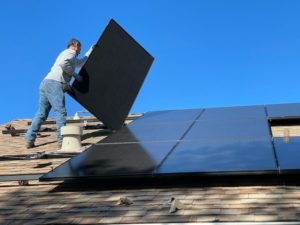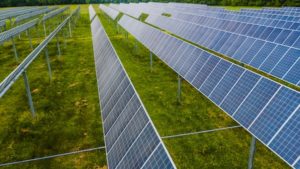Solar roof panels are the most popular way for homeowners going solar. Is your roof a match? Our solar roof guide will walk you through the three things your roof will need: 1) Strength to hold solar roof panels, 2) enough surface area to fit them, and 3) the longevity to match the roof panels you’ll have installed. Let’s look over the facts and see what this really means in practice. The information in our solar roof guide might surprise you!
- The Strength of Your Roof
- The Size of Your Roof
- The Durability of Your Roof
- Alternatives to Solar Roof Panels
The Strength of Your Roof
 For your roof to safely support panels, you’ll need a roof that holds at least 3 to 5 lbs per square foot. Each 3×5 foot solar panel weighs about 40 lbs. Most modern roofs can safely hold as much as 20 lbs per square foot, but if you have had any problems with leaks or roof integrity then you’ll want to make sure to let your solar installation company know. They can help you determine if roof repairs are needed before they add solar panels. Older homes, or homes with unusual roofs that bear weight unevenly, might need some roof repairs before you can move forward with going solar. That extra effort now will set you up for a low-maintenance system in the long run and savings on on your energy bill sooner.
For your roof to safely support panels, you’ll need a roof that holds at least 3 to 5 lbs per square foot. Each 3×5 foot solar panel weighs about 40 lbs. Most modern roofs can safely hold as much as 20 lbs per square foot, but if you have had any problems with leaks or roof integrity then you’ll want to make sure to let your solar installation company know. They can help you determine if roof repairs are needed before they add solar panels. Older homes, or homes with unusual roofs that bear weight unevenly, might need some roof repairs before you can move forward with going solar. That extra effort now will set you up for a low-maintenance system in the long run and savings on on your energy bill sooner.
The Size of Your Roof
As mentioned, solar panels are typically 3×5 feet. The average installation requires about 20 panels. This means your roof will need no fewer than 300 square feet of usable surface for the average-sized solar panel installation.
 The total area of your roof might need to be more than 300 square feet, though. Especially if your home is in Arizona, California, Utah, or a state that requires “fire setbacks.” What’s a “fire setback”? It’s necessary for firefighters to be able to access your roof. And they will need a walkable path if they have to access your roof for rescue or safety. Legal setback codes may require 3 foot wide walkways all around the roof edge.
The total area of your roof might need to be more than 300 square feet, though. Especially if your home is in Arizona, California, Utah, or a state that requires “fire setbacks.” What’s a “fire setback”? It’s necessary for firefighters to be able to access your roof. And they will need a walkable path if they have to access your roof for rescue or safety. Legal setback codes may require 3 foot wide walkways all around the roof edge.
Your local installation company will know your region’s fire setback requirements, but it’s good to be aware of this issue in advance. What if the roof you thought was perfect for solar turns out too be too small for the solar panel installation you need? Avoiding unpleasant surprises like this is one of many reasons it’s valuable to look to our solar roof guide and other helpful resources before going solar.
Your roof’s size will also decide which type of roof panel technology you should have installed, to make sure you can produce enough solar kWh for your household. That’s because the common solar panel types vary a lot in efficiency.
The Durability of Your Roof
A good home solar panel installation can last 25 to 30 years. So your roof’s durability is a key factor in deciding if solar roof panels are a good investment for you. Even if your roof is on the smaller side or not so durable, a skilled solar installation company can put together a system that offers you the best set-up possible with the home that you have. But there’s nothing an installer can do about the longevity of the roof itself! So the overall strength and size of your roof might be less crucial than its lifespan.
Do you have to pay for an entirely new roof before solar panels? Well, there might be a different option. If the roof of your home may not last the 25 to 30 years you can expect from your solar roof panels, it might be practical to explore alternatives to solar roof panels.
Alternatives to Solar Roof Panels
 Although roof panels are overwhelmingly popular for home solar, they’re not your only option. A ground-mounted system allows you to put panels in your yard rather than on your roof. This kind of system offers several benefits, including a larger area for your solar installation and more control over getting the best angle for capturing sunlight. Ground-mounted panels can also make it easy to grow your home solar installation if you think your energy needs might increase in the future. If you’re thinking about building an expansion on your home, for example, you can simply add an extra panel to your yard.
Although roof panels are overwhelmingly popular for home solar, they’re not your only option. A ground-mounted system allows you to put panels in your yard rather than on your roof. This kind of system offers several benefits, including a larger area for your solar installation and more control over getting the best angle for capturing sunlight. Ground-mounted panels can also make it easy to grow your home solar installation if you think your energy needs might increase in the future. If you’re thinking about building an expansion on your home, for example, you can simply add an extra panel to your yard.
One other option to either solar roof panels, or ground-mounted panels, is solar roof shingles or roof tiles. If you’re thinking about re-roofing your home anyway in order to install solar, this newer technology might be a better solution. Solar roof tiles may be pricier than traditional roof panels, but some homeowners find them more visually pleasing. Depending on how much wattage you need to power your household, a few solar tiles could make a big contribution to your home solar requirements.[1]Scientific American
References
| ↑1 | Scientific American |
|---|
